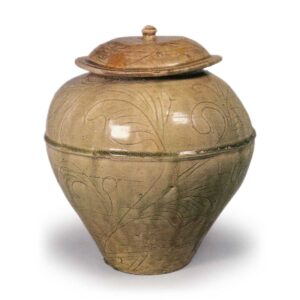
Excavated from under the Kaizan Pagoda of Nikaido Kakuenji, Kamakura-shi, Kanagawa
14th century
Height 27.7cm, Diameter 14.2cm, Body 27.6cm, Bottom 12.0cm
Important Cultural Property
Kakuonji Temple
This is a collection of bones of the monk Shinchikai, founder of Kakuonji Temple, and is said to have been placed under the andesite stone chamber of a box-shaped pagoda built in 1332.
Since Shinchi died in 1306, this wide-mouth pot is considered to date from the early 14th century.
This jar has a wide mouth with a short, upright mouth, rounded overhanging shoulders, and a slightly inward-sloping waist toward the small base. There is a single band of stripes down the center of the body, which forms part of the shoulder. The design is painted in a broad brush-and-leaf pattern that fills the entire surface of the vessel, leaving a moderate amount of blank space with flowing lines, and showing a heroic movement that overflows onto the surface. The workmanship must have been done by a very skilled craftsman. The ash glaze has a vivid light green color, and unusually for this period, it shows a stable axial tone with no unevenness in the glaze. The lid is shattered, but it is coated with a similar design of leaves and grasses on the upper surface. This wide-mouthed bowl has already been pointed out by some people to have similarities with the Southern Song celadon wine cups, and it is believed to have been influenced by them.



